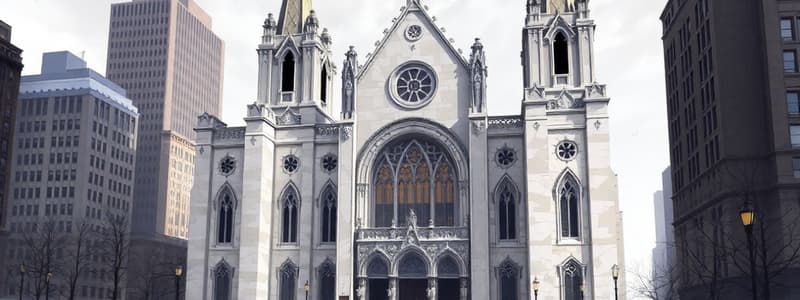Podcast
Questions and Answers
What was the primary reason the author initially welcomed the invitation to preach at Marble Collegiate Church in New York City?
What was the primary reason the author initially welcomed the invitation to preach at Marble Collegiate Church in New York City?
- He hoped to secure a permanent position at a prestigious church.
- He wanted to explore new career opportunities in a different denomination.
- He viewed it as a welcome escape from the harsh Syracuse winter. (correct)
- He saw it as an opportunity to meet influential figures in the religious publishing world.
Why did Dr. Daniel A. Poling's resignation create a challenging situation for Marble Collegiate Church?
Why did Dr. Daniel A. Poling's resignation create a challenging situation for Marble Collegiate Church?
- His replacement was not able to prevent the church from declining.
- His departure led to financial instability due to his successful fundraising efforts.
- His resignation led to a prolonged period without a permanent pastor and a subsequent decline in the church's vitality. (correct)
- His views clashed with those of the search committee, leading to a disagreement on strategy.
How did the author learn about the Marble Collegiate Church committee's interest in him?
How did the author learn about the Marble Collegiate Church committee's interest in him?
- He received a formal letter of invitation from the church's board.
- He overheard a conversation between church members after his sermon.
- He was contacted by Bishop Adna Wright Leonard, who recommended him.
- He recognized members of the committee in the congregation during his service back in Syracuse. (correct)
What impressed the author most about the members of the Marble Collegiate Church committee when they met in Syracuse?
What impressed the author most about the members of the Marble Collegiate Church committee when they met in Syracuse?
What condition did the author set before he would consider accepting a call to Marble Collegiate Church?
What condition did the author set before he would consider accepting a call to Marble Collegiate Church?
What made the First Methodist Church of Los Angeles such an attractive option for the author?
What made the First Methodist Church of Los Angeles such an attractive option for the author?
What internal conflict did the author experience when comparing the two ministry opportunities?
What internal conflict did the author experience when comparing the two ministry opportunities?
What was the determining factor that led the author and his wife to choose Marble Collegiate Church?
What was the determining factor that led the author and his wife to choose Marble Collegiate Church?
Following his decision, what immediate feeling did the author experience, reinforcing the rightness of his choice?
Following his decision, what immediate feeling did the author experience, reinforcing the rightness of his choice?
What formal step did the author take to become the minister of Marble Collegiate Church?
What formal step did the author take to become the minister of Marble Collegiate Church?
What aspect of the Reformed Church in America made the author feel welcomed despite leaving the church of his fathers?
What aspect of the Reformed Church in America made the author feel welcomed despite leaving the church of his fathers?
Who gave the charge to the new minister (the author) during the installation service at Marble Collegiate Church?
Who gave the charge to the new minister (the author) during the installation service at Marble Collegiate Church?
What was the significance of the mother's reaction to the marble blocks of the church?
What was the significance of the mother's reaction to the marble blocks of the church?
What detail emphasizes the historical connection of the Collegiate Church to the city of New York?
What detail emphasizes the historical connection of the Collegiate Church to the city of New York?
What was the original function of the building where the first religious service of the Collegiate Church was held?
What was the original function of the building where the first religious service of the Collegiate Church was held?
What policy did the Dutch West India Company implement when establishing trading posts in distant locations?
What policy did the Dutch West India Company implement when establishing trading posts in distant locations?
What does the term 'collegiate' in Marble Collegiate Church signify?
What does the term 'collegiate' in Marble Collegiate Church signify?
What factor played a significant role in the Marble Collegiate Church getting its name?
What factor played a significant role in the Marble Collegiate Church getting its name?
What was the financial situation of Marble Collegiate Church at the time the author was considering becoming its minister?
What was the financial situation of Marble Collegiate Church at the time the author was considering becoming its minister?
What was the attendance situation at Marble Collegiate Church when the author first preached there?
What was the attendance situation at Marble Collegiate Church when the author first preached there?
Flashcards
Desire for Respite
Desire for Respite
A feeling of needing a break from something, often cold weather.
Marble Collegiate Church
Marble Collegiate Church
Located on Fifth Avenue in New York City, it was without a spiritual leader for two and a half years.
Minister, Elder, and Deacon
Minister, Elder, and Deacon
Name of the religious organization associated with Marble Collegiate Church.
Dominie
Dominie
Signup and view all the flashcards
Collegiate
Collegiate
Signup and view all the flashcards
Classis of New York
Classis of New York
Signup and view all the flashcards
Peace and Knowledge
Peace and Knowledge
Signup and view all the flashcards
Installation Service
Installation Service
Signup and view all the flashcards
Study Notes
- In the 1930s, Syracuse winters were long and harsh, motivating the author to accept an invitation to preach at Marble Collegiate Church in New York City in March 1932.
- The author's wife, Ruth, eagerly agreed to the trip to New York City.
- Bishop Adna Wright Leonard preached at University Church in the author's place.
- Marble Collegiate Church had been without a pastor for two and a half years after Dr. Daniel A. Poling resigned.
- Dr. Poling had a successful tenure at Marble Collegiate Church and prevented its abandonment.
- The church had significantly declined in the time since Dr. Poling's departure.
- The search committee had not been able to find a new pastor.
- On March 13, 1932, the author preached at Marble Collegiate Church due to the scheduled preacher's sudden illness.
- Ruth met with her Syracuse classmates and sorority sisters at the church service.
- A church member was surprised to learn Ruth was the visiting minister's wife.
- The congregation was small but dedicated, and the church had a charming atmosphere.
- The author noticed two men from Marble Collegiate Church in his Syracuse congregation the following Sunday.
- The men informed him that a committee had come to hear him preach and wanted to discuss the church with him.
- Marble Collegiate Church belonged to the Minister, Elder, and Deacon of the Collegiate Reformed Protestant Dutch Church of the City of New York.
- The church's first service was held on April 9, 1628, in a gristmill in New Amsterdam, which had a population of about 300.
- The church had held a Sunday worship service every Sunday since its founding.
- The Dutch West India Company always brought a "Dominie" (pastor) to their trading posts.
- The first dominie was Jonas Michaelius, and governors like Peter Stuyvesant were church members.
- Peter Minuit, who bought Manhattan, was one of the first deacons.
- The church was built of marble from Hastings-on-Hudson.
- The term "collegiate" referred to the four separate buildings, each with a minister and congregation but under one governing body.
- The Collegiate Church had joined the Reformed Church in America over 125 years prior.
- The committee believed that Marble Collegiate Church could recover under strong leadership and have a national and international impact.
- The author was in agreement with the committee's positive thinking.
- The committee was convinced that the author's preaching was what they were looking for.
- They acknowledged the church's small congregation but believed in its potential.
- The author had already accepted an invitation to preach for a month at the First Methodist Church of Los Angeles and might become its minister.
- The committee agreed to wait a month for the author's decision.
- The author preached to large congregations at the First Methodist Church in Los Angeles, which had 3,000 seats.
- He received an official invitation to succeed Dr. Elmer Ellsworth Helms as minister.
- The author needed time to decide between the opportunities in Los Angeles and New York.
- The author and his wife were indecisive about where they could best serve.
- First Methodist in Los Angeles was one of the largest and most vital churches in America, with over 7,000 members.
- Marble Collegiate was struggling and had almost been closed down by a motion in the official board.
- Marble Collegiate's membership was approximately 500, with an active membership of around 250.
- The church's annual expense budget was $15,000, with $10,000 coming from one man, Mr. E. Francis Hyde.
- Attendance was low, with about 215-225 people at services.
- The author considered whether he wanted to revive a dying church or maintain a successful one.
- He had a history of being a church troubleshooter.
- The author leaned towards going to Los Angeles.
- The New York church was located in a decaying part of Fifth Avenue.
- The Los Angeles church had distinguished leaders in its membership, while Marble Church did not.
- The author struggled with the decision of choosing between an already great church and one where he could make something out of practically nothing.
- The author and his wife prayed for God's guidance in making the decision.
- They wanted to serve most effectively for Christ and asked God to remove all material considerations.
- The author and his wife attained a spiritual state of willingness to let God direct their lives.
- They received a definitive answer to go to New York.
- The author called Mr. William S. Denison and accepted the call to Marble Collegiate Church.
- He felt great peace and knew he had made the right decision.
- The author went to New York City to be transferred from the Methodist denomination to the Reformed Church in America.
- He felt a twinge as he left the church of his fathers but was comforted by the fellowship of Christian brothers.
- The certificate of his ordination in the Methodist Church was accepted.
- The author climbed to the open upper deck of a bus, looked back at Marble Church, and knew it was his spiritual home.
- The installation service at Marble Collegiate Church was held on October 2, 1932, and the main sanctuary overflowed.
- The service was presided over by Rev. Dr. Oliver P. Barnhill.
- The charge to the people was given by Rev. Dr. Edward Dawson.
- The sermon was preached by Dr. Charles E. Jefferson.
- The charge to the minister was given by the author's father, Rev. Dr. Charles Clifford Peale.
- His father said he had never been disappointed in him and would not be now.
- The author's mother was weeping outside the church and told him to always keep the church strong.
Studying That Suits You
Use AI to generate personalized quizzes and flashcards to suit your learning preferences.




